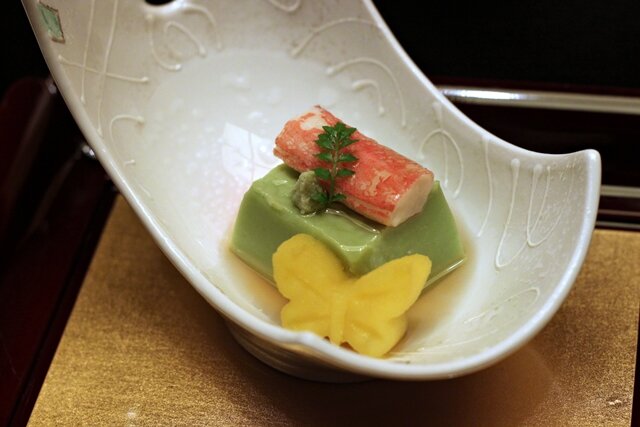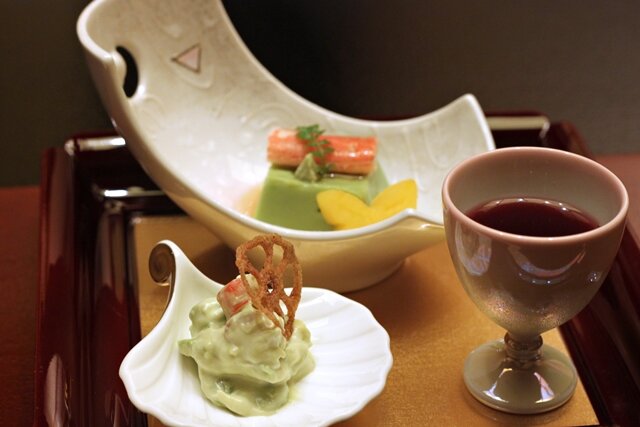Cha-kaiseki made me realize that I’m not Japanese.
Of course, I already knew that, but many of my friends have joked that I must be Japanese, as there’s so much I appreciate about the cuisine and the culture. Or so I thought, until I encountered cha-kaiseki. Actually, in discussing my cha-kaiseki experience, I’ve come to a conclusion that some of my Japanese friends are not truly Japanese!
I knew next-to-nothing about cha-kaiseki when Hiroko Sugiyama invited me to her house for the experience. A quick Google search revealed that cha-kaiseki is a meal with many rules. Even before I arrive, I’m already breaking one by being late. I apologize profusely to Sugiyama and the three other guests, wondering aloud why President Obama had to come to Seattle this day, his motorcade causing roadblocks.
Before long, I learn that I’ve technically broken two rules before arrival. Sugiyama tells us that after receiving an invitation to cha-kaiseki, a guest should stop by the host’s home to express gratitude—and nothing more.
Serving us a starter drink of kumidashi, Sugiyama explains that cha-kaiseki is a “humble meal” that’s light on the stomach (there will be more liquids than solids) so that guests can appreciate the tea ceremony that follows. Our focus tonight will be the meal itself, which should only take one hour, whereas an entire chaji (formal tea ceremony) would be about four hours, including laying charcoal, admiring scrolls and kettles and such, and to-dos I’ve already lost track of.
The foundation of the meal is ichiju sansai, which means one soup and three sides, plus rice. Sugiyama places the initial tray before me, which contains side-by-side lidded bowls of rice and soup, and mukōzuke (meaning “set to the far side”) on the other side of the tray. The mukōzuke is an open bowl with some sashimi slices of tuna. The rice is sculpted into an “ichi” (one) shape, signifying its importance. I’m told to put the lids inside each other—though there’s some rule about putting them back on the bowls when the host enters the room—and Sugiyama gives a lesson on the proper way to hold chopsticks and bowls, scolding me when I slide a bowl along the tray instead of lifting it to protect from scratching the lacquer.
At one point in the meal, sake is poured, and I learn how to work the apparatus and hold the cup—this after bowing to the host in an appropriate way.
After mukōzuke comes a nimono dish (ebishinjo—a shrimp dumpling in broth) followed by the last of the sansai—the yakimono. Guests pass a shared platter of grilled salmon and asparagus, with one piece each per person. Now there’s an opportunity for extra rice (we’re told to measure our quarter-portion carefully) and extra soup, then come extra courses:
- Suimono, a small clear soup which also serves as a chopstick cleanser
- Hassun, bites from the mountain and sea
- Yutō, slightly browned rice in hot water, poured from a lacquer pitcher
Accompanying the yutō is kōnomono, which are pickles. We each get two pieces of cucumber and two pieces of takuan (pickled daikon radish), and Sugiyama tells us to reserve one piece of takuan.
Since bowls are reused, we take the takuan and use it to rub and clean the bowl. But, I’m scolded, only when there’s liquid in the bowl. In fact, guests are expected to bring their own kaishi (paper towel or soft cloth) for cleaning bowls, as well as a plastic bag to store the kaishi and any inedibles.
The hassun course includes shishito peppers. My tablemates, largely silent during out “studied” meal (guests shouldn’t actually talk much, but instead concentrate appreciatively on how the host made the meal), wonder what to do with the shishito stems. I hide mine and tell Sugiyama that I simply threw it under the table. She smiles and playfully punches me in the arm, all the while remaining vigilant about the rules and rituals. Later, she confesses to me that she was too busy to remove the stems.
We’re all a bit baffled by the rules, but amused by some of them. Sugiyama says that after omogashi (dessert course), all guests should count to three, then drop their chopsticks (holding them dead-center) from an inch above the tray, as the sound tells the host that everyone’s done eating. She emerges from the kitchen and apologizes, saying, “Sorry my food wasn’t very good,” to which we guests must immediately assure her that it was oishii (delicious). We each then give her our tray, bowing quietly.
There will be similar ritual, including bowing and bowl-turning, during tea service, which occurs after time in the garden if part of a longer chaji experience. On this occasion, we move immediately to the matcha (koicha, the thick, frothy brew), with the first guest saying to the second “excuse me for going before you” before sipping. Then the second to the third, and so on around the table.
And that’s it. I’m still hungry, and wonder if there’s a Dick’s nearby so I can buy a burger. As a dining experience, part of me wonders if, with all the rules, cha-kaiseki is more punishment than pleasure.
But then I realize that this is about more than the food. It’s gastronomy as art. Sugiyama beams with pride: “The tea ceremony includes all aspects of Japanese culture: cooking, architecture, interior design, gardening, calligraphy, ikebana (flower arranging), and craftsmanship—of pottery, wood-working, ironwork/metal, and fabrics….The objects in and around the meal are all art pieces, meant to be admired.”
In fact, cha-kaiseki strikes me as a sort of performance art. Instead of a meal, it’s an event about hospitality—even if the rules feel rigid at times. For me, it’s a source of learning and an experience to remember. For the Japanese, it’s a way to hold on to heritage.
This is why Sugiyama values cha-kaiseki. It’s expensive and takes time and sacrifice (Sugiyama says “you have to slave to work”), but with work comes peace and purification. And as a guest, one of the best ways for me to express my gratitude is with silence.
Sugiyama walks us to the door to see off the guests. I feel her presence behind me, and know that if I turn around, she’ll bow. I realize: Maybe I’m not Japanese, but Sugiyama certainly is.
Note: I wrote this piece in conjunction with a kaiseki/Kyoto-cuisine article appearing in the current issue of IBUKI. That magazine is available at Uwajimaya and other Asian establishments in the Seattle area, and you can also read the article online on pages 8-13.
Hiroko Sugiyama is owner of the Hiroko Sugiyama Culinary Atelier in Sammamish, where she teaches a number of interactive classes. My experience was just part of her seasonal cha-kaiseki class, which includes meal preparation. Without knowledge of all the etiquette, you’d unlikely ever be invited to actual cha-kaiseki. Fortunately, Sugiyama makes the experience educational and enlightening.
















